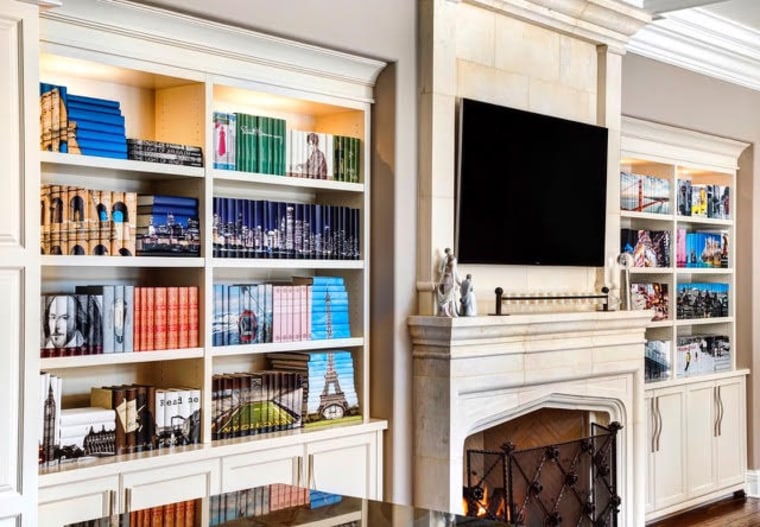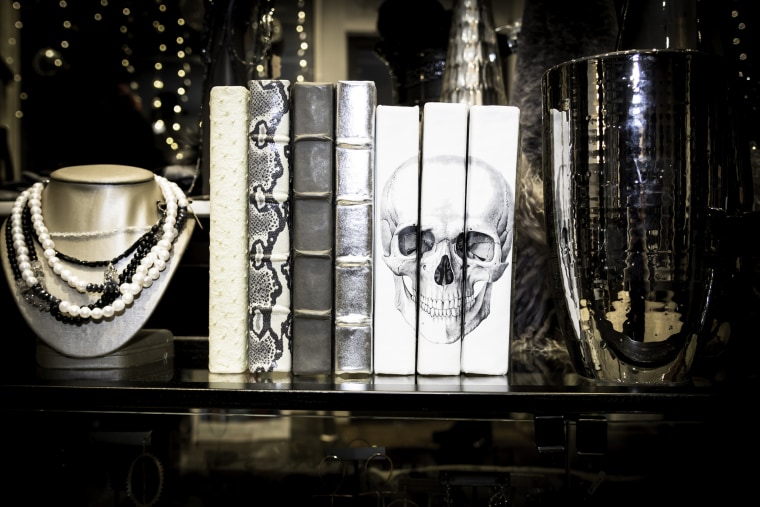While the great shift to digital has greatly impacted physical book sales, consumers haven’t lost their taste for the touch of a real, tangible book: Last year, NPD BookScan reported that in 2018, sales of print books were up 1.3 percent compared to 2017. Books, it seems, are moving off the endangered species list that has claimed newspapers and other print media.
But books, like all physical stuff, need a place to go, and here, dear reader is where I profoundly struggle. I’m an avid book collector who runs an Instagram account dedicated to my ever-expanding library, and a corresponding monthly book club. I have hundreds of books, from coffee table tomes to tattered paperbacks and they are all over the house.
What is a personal library curator? A book lover with an eye for design
When I read this past week that Gwyneth Paltrow hired Thatcher Wine, a library curator, designer and the founder and CEO of Juniper Books, to curate her book collection, my initial reaction might just have been a big old eye roll. Hiring a book curator struck me as ostentatious and even pretentious, but then I looked at Wine’s work and at images from his forthcoming book “For the Love of Books: Designing and Curating a Home Library,” and was awestruck. Wine’s curated collections and custom book jackets demonstrate how books can be meticulously choreographed to transform ordinary shelves into artistic masterpieces.
“I don’t think of myself as a celebrity bibliophile or as a librarian to the stars, which is what I’ve been called lately,” says Wine, whose wave of Paltrow publicity has been sparking snarky threads on Twitter, like this one. “This was a hobby I turned into a business in 2001 after I was burnt out from tech [jobs] out of college. I started going to estate sales and auctions and buying rare books and first editions, and someone asked if I could curate a library for their new house.”
Wine took the gig and from there, a bona fide business was born. Juniper Books not only curates library collections, but also designs custom jackets, special editions and has a seasonal subscription program. “We just love books and sharing books and want to reinvent them for the next 500 years,” says Wine.
Give yourself permission to look at your books as objects while you’re not reading them. Let them do something for you while you’re waiting to come back to them.
Thatcher Wine
Judging a book by its cover doesn’t have to be a bad thing
What Wine seems to desire to reinvent most about books, is our perception of them not only as sources of information and wisdom, but as things of beauty and character.
“Historically, people have felt that you can't play with your books or look at them as objects,” says Wine. “There has been some intellectual snobbery; the idea that books are just meant to be read, but the reality is you can't read all your books at one time, and if you’re a book lover like we are [at Juniper], you may have dozens or hundreds of books. You keep them because you plan to read them later, or to remind yourselves of what you’ve read, or to project a representation of who you are to others.”
“Give yourself permission to look at your books as objects while you’re not reading them,” says Wine. “Let them do something for you while you’re waiting to come back to them.”
You don’t need to spend a penny to have a bookshelf that tells a story
I’m quick to lightly nip at Wine’s enthusiasm, countering that most people cannot afford to replace all their books with new matching editions and/or customized jackets, let alone hire a personal curator to overhaul their home library.
Wine replies that one doesn’t have to retain a high-end service like Juniper Books to bring new life to their bookshelves; indeed, one doesn’t have to spend a penny at all.
A beautiful bookshelf that “tells your story”, as Wine says, is actually “very attainable”; this is in part because bookshelves that make a statement are a blossoming trend.
“Books are back and take center stage in the home,” says Jason Saft, a real estate agent in NYC with Compass, who also has his own home staging business. “Design trends via Instagram have created a whole new view on the written word and the at-home library. How you display your books for yourself, and your followers, says so much about you.”
Mark Cutler, an interior designer in Los Angeles, opines that the rise of electronic readers has, in a sense, raised the aesthetic bar of the bookshelf.
“In the past, what was on your shelves was much more important than how your shelves were displayed and this new focus has created some really fun and interesting was to decorate your shelves,” Cutler says.
Here are some exclusive insights from Wine and other design experts on how to give your treasured books the home they deserve.
Empty your shelves and take a Marie Kondo approach
The first step in making over your library is to empty the shelves completely.
“I recommend starting from a blank slate, so take all the books down from the shelves. Dust and clean the shelves and readjust heights if they’ve been bothering you,” says Wine, who adds that you want to bring in a bit of a Marie Kondo decluttering approach, by assessing which books you still really need in your life. “Let go of books that don't tell your story. If you have books about a hobby you’re no longer into, donate those books to a thrift store or a library.”
If you find yourself on the opposite end of the book owner spectrum, where you actually don’t have many books to display, you should find plenty of interesting options at flea markets, thrift stores and even the discount shelves at your local bookseller.
“For statement books, the bargain rows at bookstores like Barnes and Noble have more affordable coffee table sized/subject books,” says Carly Pokornowski Moeller, a registered interior designer and the owner of Unpatterned. “You can often find decent coffee table style books intermixed in the home decor items in discount stores like HomeGoods.”

Organize by section, much like a bookstore does and choose a color scheme
Katy Winter, founder of Katy’s Organized Home, recommends organizing your books by “very general categories: Coffee table or [extra large] books, biographies/history books, travel books, novels, for example. Try not to get too specific.”
From there, Winter recommends deciding on a color scheme that works for your room.
“The current trend is to rainbow your books, but there are many options,” says Winter. “Some clients prefer white, gray and black, or blues and greens for a color scheme. We just make sure to plan out where we want the colors before placing the books.”
To help envision this Winter suggests you “imagine a center vertical line. Put some white on one side and the same amount of white on the opposite wall. Play around with your books by mirroring them and creating balance. We think about the colors on the bookshelves as artwork. You want it to be visually pleasing.”
Remove dust jackets from hardcovers
Creating a monochromatic scheme is much easier once you strip hardcovers of their dust jackets.
“Remove the dust jackets from hardcover novels, business/self-help books and even coffee table books,” says Pokornowski Moeller. “Often a simpler, less colorful and more streamlined book exists below the cover art. This can unify an unrelated collection, and it can also often elevate the look of a stack of books.”
Stack some books vertically, some horizontally with cherished knick-knacks in between

“Alternate standing your books upright and laying them flat to make it look more interesting,” says Ginny Underwood, owner of Virginia's Easy Living Solutions, a stylish technique that Wine also recommends, especially if you have books of varying sizes. “Horizontal stacks should be significantly lower or higher than the upright books they’re near. If lower, this is a great opportunity to continue layering by adding a succulent, a golden trinket, a tiny globe, candle or milkglass,” adds K.M. Robinson, an author and social media strategist who teaches her fans how to stylize their shelves to market or show them off on the ‘gram.
“In the book world, mugs are also a gorgeous way to not only accent the shelves, but to hold books up,” says Robinson. “Colorful and fun mugs can be rotated around the shelves, and even swapped out for morning coffee time, giving [you] extra cabinet space while showing off mugs that are too pretty to have ever been trapped inside a cabinet.”
If you are going to spend, invest in bookends
While you can absolutely use sturdy knickknacks to do the job of bookends, you might want to buy the real deal. They’ve made quite a comeback in boutique-type stores.
“Another trend that has become incredibly popular is unique and decorative bookends,” says Sherri Monte, who co-owns Elegant Simplicity, an interior design and home organizing firm with her husband, John. “You can find a great selection of affordable bookends that add pops of personality and really dress up your bookcases at Anthropologie or CB2.”
Aim for two-thirds books, one third accessories
Balance is integral to creating a bookshelf that pops, and Wine finds that aiming for two-thirds books and one-third accessories per shelf can be the magic ratio, though he says some of his clients, like Paltrow, prefer a more minimalist look, with around 40 percent books.
After stocking each shelf, Wine recommends taking a step back and examining both with your eyes and with your phone.
“Take a photo — you'll notice things you didn't notice with your naked eye,” he says.
Maintain a theme in each room
You can use these tips for every room in your house, Wine says, the only thing you’ll want to keep in mind is not blurring themes.
Keep cookbooks in the kitchen, “with possibly a bottle of olive oil or cooking utensil as a bookend,” Wine says, adding that perhaps the office bookshelves can focus more on memorabilia, gifts and/or family photos you might want to look up at while you’re working. Your nightstand should be the least bookish, housing “only the books you’re reading right now.”
Above all, let this be joyful, creative and an opportunity to flaunt not just your intellect, but your personality. For more inspiration, I recommend browsing the #bookstagram hashtagged posts on Instagram where you’ll find an endless trove of inspiration.
More from BETTER
- Why 'getting lost in a book' is so good for you, according to science
- Small home updates you can make right now that will boost your health and happiness
- How to be a better reader
- How to organize any space in your house
Want more tips like these? NBC News BETTER is obsessed with finding easier, healthier and smarter ways to live. Sign up for our newsletter and follow us on Facebook, Twitter and Instagram.

